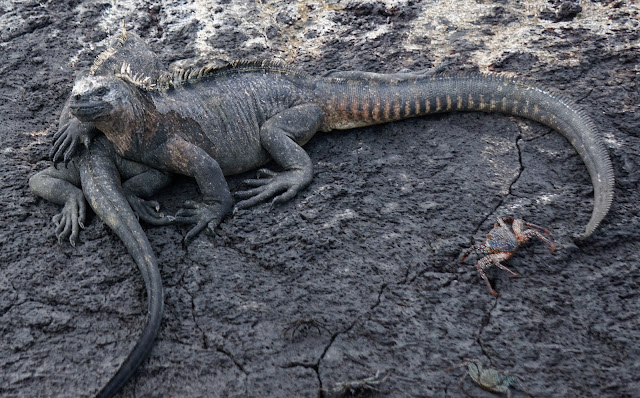March 22, 2022
During the night we sailed from Puerto Ayora to Punta Moreno, located on the largest of the Galapagos Islands, Isla Isabela. We spent the morning boating around Punta Moreno, and in the afternoon we traveled a little further up the coastline to Elizabeth Bay, shown below.
However, the next morning I was able to keep my breakfast down and join the others on an inflatable motorized raft, which I learned is called a panga, for an expedition to explore the coastline of Punta Moreno on the island of Isabela. There it is in the distance, as seen from our catamaran:
We were not allowed to actually land and disembark on this day, but we still had some amazing experiences.
First, we pulled up alongside a coastline covered with a dense mangrove thicket.
Pelicans are huge, clumsy-looking birds with what looks like a toupee instead of feathers on their wings--at least from this angle.
We had what we call a "National Geographic Moment" while we were floating offshore from the nesting area. A parent pelican flew in and opened his/her bill to expose the pouch underneath. The babies--more like snotty teenagers, really--aggressively shoved their bills and heads into the open maw and gobbled up what was inside. At times it seemed that their bills reached far beyond the parent's pouch and down the throat. It was shockingly violent. The parent had to flap his/her wings to keep balance on the branch, and between the flapping and digging, it looked like a full-scale attack.
Can you visually untangle the mess of bodies below? The chicks were even trying to steal food from each other. Survival of the fittest, indeed.
In the same area, we saw some striated herons (aka lava herons), unperturbed by the war going on in other trees. Here is a juvenile:
. . . and here is an adult. The two birds don't look like the same species!
 |
| Photo by Bob |
. . . where we spotted our first of many marine iguanas.
. . . many intricately speckled with tiny dots . . .
. . . and others with other patterns.
These crabs are the garbage collectors of the Galapagos Islands. They eat just about anything that washes ashore, along with ticks on iguanas and even other crabs. Where did they get their name? Supposedly they are named for a Caribbean dancer of that name because of their agility. They have ten legs and can run in any direction.
The marine iguana is the only lizard in the world that lives in a marine environment and forages for algae in the sea. It is endemic to the Galapagos Archipelago. There are twelve or thirteen subspecies on the islands, but this species and the one on Fernandina Island are the largest. This subspecies can weigh up to 26 pounds.
The Galapagos Islands have a way of producing strange-looking, or at least very unique, animals. Take the flightless cormorant, for example, which can also only be found in these islands. Its wings are mere stubs, not nearly large enough to lift it from the earth.
The sheer amount of wildlife is impressive. Here we have crabs, iguanas, Galapagos penguins, and blue-footed boobies, all hanging out together on the same rocks.
Who knew there were penguins north of the equator? These are the only ones--and they are endangered. Fewer than 2,000 are left.
We saw lots of blue-footed boobies. Their name is derived from the Spanish word "bobo," which means "fool." They definitely don't seem like they are very smart. They aren't afraid of anything, which makes them very easy to catch (unlike the Sally Lightfoot crabs, which are impossible to catch).
The morning flew by, and before long it was time to return to the Alya for lunch.
Every meal we ate on board was high quality. For our first lunch we had broccoli-cauliflower soup; a green salad with add-ons like beets, lima beans, and corn nuts; fried potatoes, and fish filets.
After lunch we headed back out in the pangas to explore Elizabeth Bay. We had a panga full of people on either side of this rock peninsula,
But the boobies remained oblivious to our presence. I like how this one is at military attention with his arms crossed behind his back. Or maybe he's showing off because that wingless cormorant to his right has such pathetic wings.
They look like they've dipped their webbed feet into a can of beautiful turquoise-colored paint.
Of course, the pelicans didn't seem to care much about our proximity either.
The mangrove trees are huge--not bulky, but very tall.
In addition to what we had seen in the morning, we also saw sharks, some seals, and a few sea turtles.
More Galapagos penguins:
. . . before another delicious meal of pineapple and apple salad; pasta pomodoro (me) and pasta carbonara (Bob), and a phyllo pastry topped with custard for dessert.
Sweet dreams.



.JPG)


.JPG)

.JPG)

.JPG)
.JPG)








.JPG)

.JPG)


.JPG)


.JPG)



.JPG)






.JPG)

.JPG)















You held back on the sailing. That first night was pretty rough. The food the whole trip was great.
ReplyDelete